Data Communication
Data communication refers to the process of transmitting and receiving information between two or more devices or systems. It involves the exchange of data through various mediums such as cables, wireless connections, or even satellite links. This communication can occur locally within a network or globally over the internet. Data communication plays a crucial role in enabling the transfer of data, whether it's text, images, videos, or any other form of digital information, from one point to another. It encompasses the protocols, technologies, and infrastructure required to ensure reliable and efficient transmission of data across different devices and networks. Types of Data Communication Data communication encompasses various types of information exchange methods. These methods can be classified into different categories based on their characteristics and functionalities. One type of data communication is wired communication, which involves the use of physical cables or wires to


